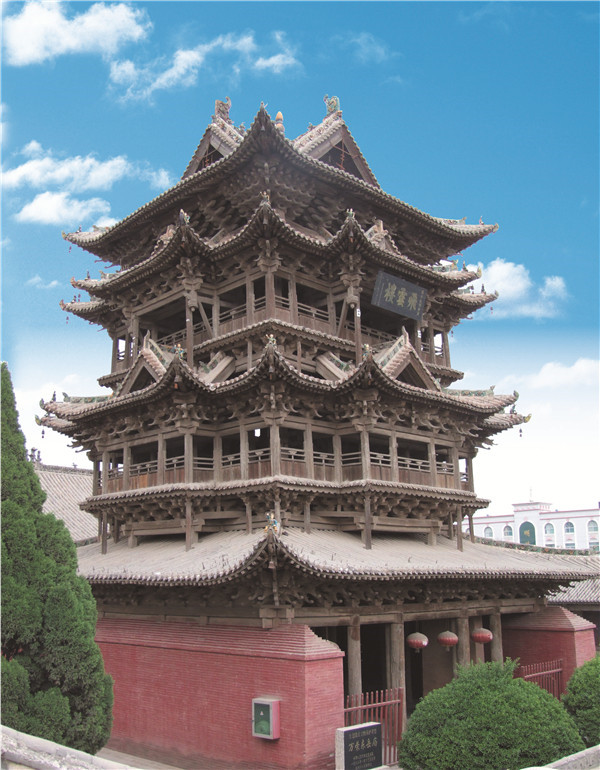
Feiyun Tower is located in the Dongyue Temple in Wanrong County, a national key cultural relic protection unit. Feiyun Tower has four main features: first, it is pure wood structure, no matter it is large or small interface, all uses tenon riveting to cover, without an iron nail; The second characteristic is that its ground floor is square, with five rooms in width and depth, leading from north to south, and wooden columns standing in great numbers. In the middle, there are four pillars leading to the roof, and the 32 wooden columns around the building are cleverly arranged in a chessboard to support the building. The third feature is that it has three layers of light and five layers of darkness: the second and third floors each has a room, each equipped with railings for maintenance. It is divided into three rooms by two flat columns, built a roof over it, pediment forward, underside with interspersed material support, with clever structure. The fourth feature is the third layer with four drops of water and the cross “xieshanding” roof style. There are 345 groups of brackets and 32 groups of rake angles in the whole building, with exquisite appearance, constituting the extremely rich contour line of the building, and varied in form, as the clouds gather round the blooming flowers, The angle of each eave and wing is warped, giving people the feeling of flying in the sky. And because brackets are stacked, like the cloud belt winding, it got the name Feiyun Tower.
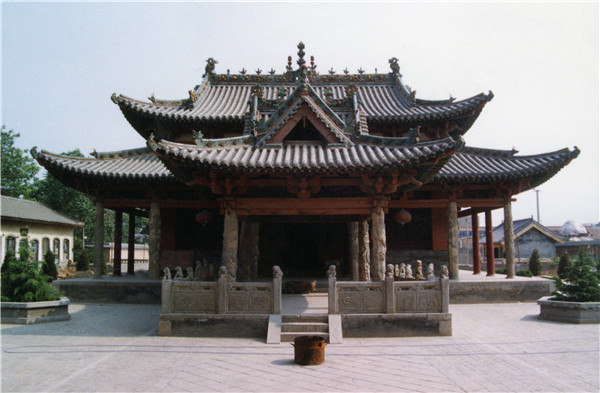
The central axis of Dongyue Temple has Feiyun Tower, Meridian Gate, Xiandian Hall, Incense Pavilion, Main Hall, Palace of Hell and other ancient buildings, covering an area of 10,600 square meters. In recent years, we have invested more than 2 million RMB in the repair of Xian Hall, Xiang Pavilion, the Main Hall, etc., and the maintenance program of Feiyun Tower itself is being prepared. At present, we are implementing the reconstruction and expansion of the scenic area. In the protection of cultural relics while enriching the connotation of the scenic area, with rich cultural resources to promote the development of the scenic area, we will ensure visitors to enjoy the unique history and culture of ancient architecture.
"There is a Feiyun Towe in Wanrong County, where half of the tower steeps into the clouds." Feiyun Tower is the outstanding representative of the ancient Wanrong Dongyue Temple and the landmark of Wanrong County.
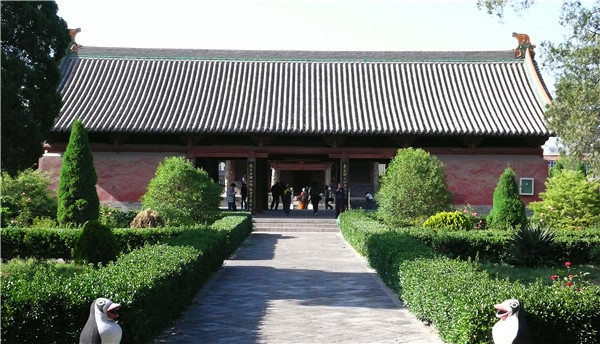
Wanrong Dongyue Temple is a national key cultural relic protection unit. Here is the statue of Emperor Dongyue of Huangfeihu. Emperor Dongyue is also known as Mount Tai god, as well as Mount Tai Temple. Its architectural layout is followed the architectural characteristics of the ancient Chinese palace, sitting north to south, front court and behind bedroom. It is 75.1 meters wide from east to west and 210 meters long from north to south, covering a total area of 16,000 square meters. It's a building that sits on a central axis. From the south to the north of the mountain gate, it contains Feiyun Tower, Meridian Gate, Xian Hall, Incense Pavilion, the Main Hall, Hades Palace and Hell. The existing buildings mainly reflect the legacy of the Yuan and Ming dynasties, but also retain some building techniques and styles of the Qing Dynasty.
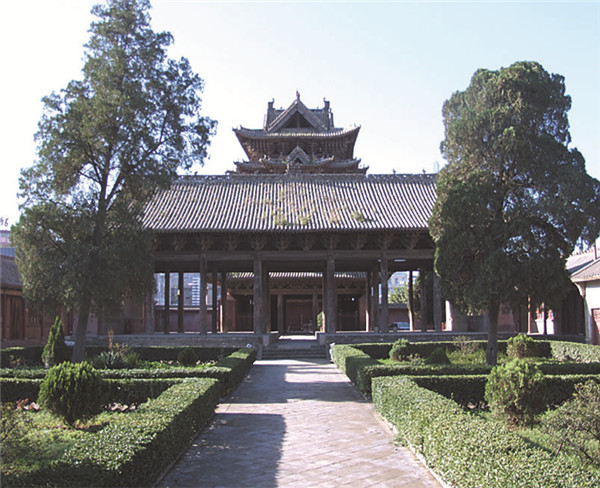
According to the “Tablet Inscription of Refurbishing Yunfei Tower”, written during the reign of Qianlong in the temple: there is a town on the 15 Li (a Chinese unit of length (= 1/2 kilometre)) away from Yebei in Wanyi County, called the Haidian, which is in the east corner of the town. There is the temple of Dongyue from the ancient times, without the founding year, recorded in the city annals. In the first year of the reign of Emperor Zhenguan of the Tang Dynasty, when Fen Yin was the name of Fen County, there was this temple." It can be seen that the temple was founded at least before the Zhenguan of Tang Dynasty, about 1400 years ago. There is a local legend: at the end of the Sui Dynasty, the world chaos. At the age of 18, Li Shimin, the king of Qin, raised his troops from Jinyang and launched a campaign to conquer the east and the west. Unexpectedly, in the second year of Wude of Emperor Gaozu, Wang Hangben and Lyu Chongmao occupied Puzhou. There is a rebellion in Xiaxian County, Li Shimin then led the expedition directly into the Longmen Pass, passing through Xiedian, Zhangweng and Gucheng, and encamping himself in these three places to create a situation of containing the enemy or supporting each other. After the counterinsurgency, Li Shimin built one Dongyue Temple in each of the three places and one Yuelou Tower in Haidian and Zhang Weng in order to publicize his achievements. The other two temples have been destroyed in the war, only Feiyun Tower and Dongyue Temple have survived, furrowed by rain and wind and many times of maintenance in different dynasties and generations.
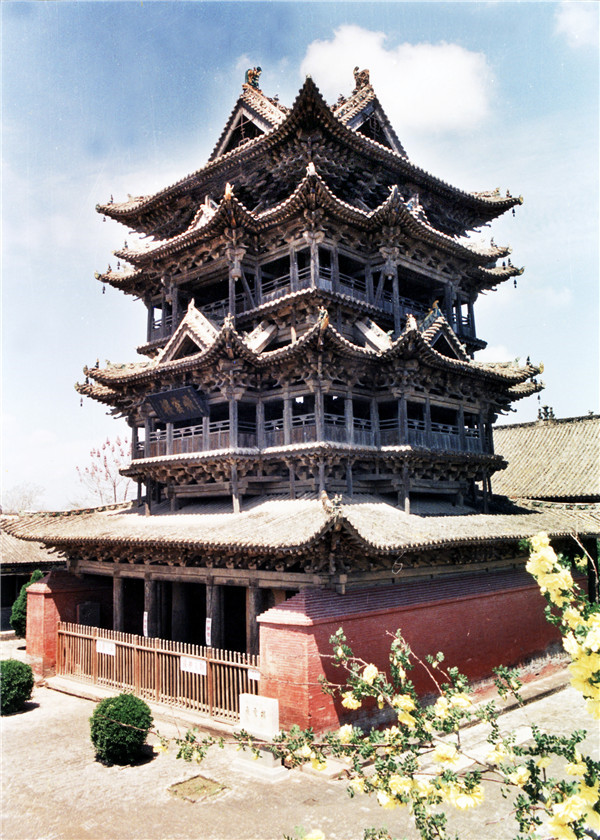
【Feiyun Tower】
Standing on the central axis, Feiyun Tower, with the reputation of "the first wooden building in China", is set in front of us. The height of the building is 23.19 meters, which is as famous as Wood Tower in Yingxian County and is honoured as “North tower and South building” in Shanxi.
The building of Feiyun Tower has four main features: first, it is pure wood structure, no matter it is large or small interface, all with tenon riveting to cover, without an iron nail; The second characteristic is that its ground floor is square, with five rooms in width and depth, leading from north to south, and wooden columns standing in great numbers. In the middle, there are four pillars leading to the roof, and the 32 wooden columns around the building are cleverly arranged in a chessboard to support the building. The third feature is that it has three layers of light and five layers of darkness: the second and third floors each has a room, each equipped with railings for maintenance. It is divided into three rooms by two flat columns, built a roof over it, pediment forward, underside with interspersed material support, with clever structure. The fourth feature is the third layer with four drops of water and the cross xie shan ding. There are 345 groups of brackets and 32 groups of rake angles in the whole building, with exquisite appearance, constituting the extremely rich contour line of the building, and varied in form, as the clouds gather round the blooming flowers, The Angle of each eave and wing is warped, giving people the feeling of flying in the sky. And because brackets are stacked, like the cloud belt winding, it got the name Feiyun Tower.
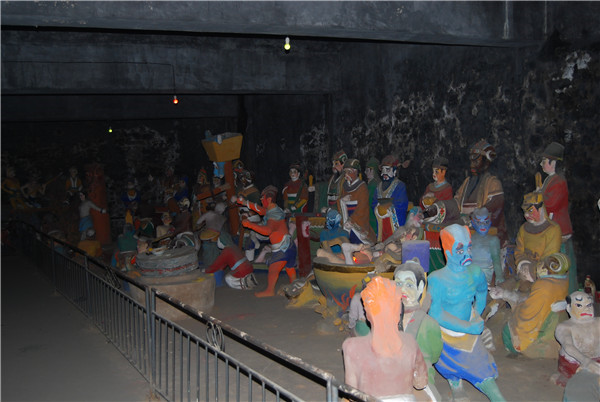
【The Meridian Gate】
Passing through Feiyun Tower, it is Meridian Gate. Meridian Gate belongs to the building built in the Yuan dynasty and rebuilt in the Ming Dynasty, with seven rooms in width, six rafters in depth. Xie hill top is 7 meters high, the truss is simple and the dougong is neat. On either side are 28 monuments bearing the names of the fundraisers in the construction. Here, meridian gate does not play the role of the door, just a symbol, but also to promote the status of Huang Feihu, the god of Mount Tai which is also called Dongyue Mountain.
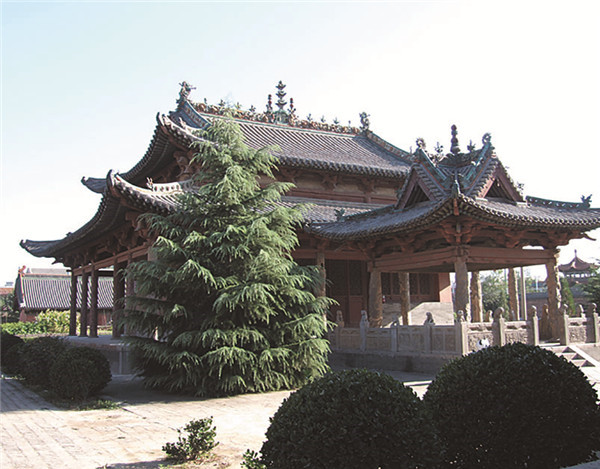
【Xiandian Hall】
Passing through the Meridian Gate, it is Xiandian Hall. Its architectural structure belongs to the Yuan Dynasty style, with seven rooms in width with flush gable roof. Xian Hall is a place where tributes are displayed. On every March 28, the birthday of Emperor Huang Feihu of East Mountain in the ancient calendar, people around will gather here to pay homage to Emperor Huang Feihu of East Mountain, praying for good weather and good harvest.
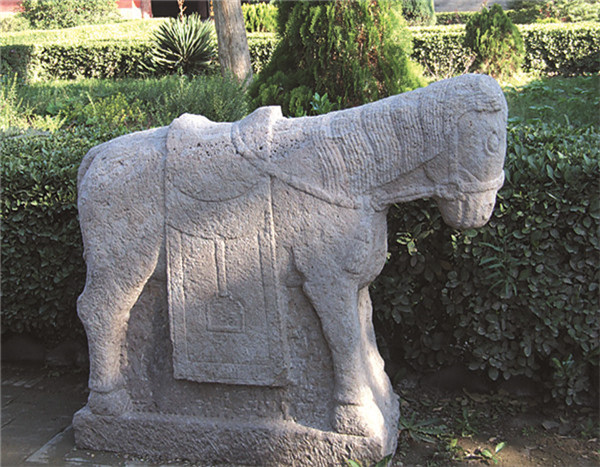
【The Incense Pavilion】
As the name suggests, Incense Pavilion is where incense is burned. The colored drawing in Incense Pavilion is gorgeous, the coloured glaze has ridge line, with clouds billow and dragon prancing on the fences around it. The carved work of each pillar is fine and vivid, which is the style of stone carving in Zhengde period of Ming Dynasty. Four dragon stone pillars are carved in different ways, three of which are wreathed by floating clouds and hovering dragons, only the pillar in the northwest corner is a lone dragon. It is said that when the Incense Pavilion was built, there was a master and his three apprentices. The master was a master craftsman and was very strict with his apprentices. To test his apprentice's skill, he gave each of them a stone pillar and stipulated that they could not look at each other. So each of them racked his brain and carved with great care. On the day of completion, when the master saw the works of his disciples, he saw that what they had carved were all flying dragons leaping up and looking up at the stigma. Only his was a lone dragon, far inferior. On the one hand, the master felt happy for his apprentices' "surpassing the teacher", but on the other hand, he felt ashamed. So he left quietly in unawareness. At that time the supervisor intended to let his apprentice engrave again, but because the time was too tight, he had to make do with it, then into a regret.
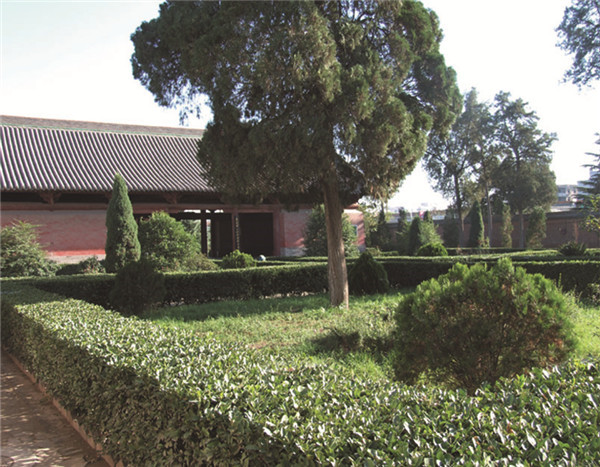
【The Main Hall】
The Main Hall is five rooms wide, with double eaves on the top of the hill. Most of the beams in the hall are logs, still in the shape of the Yuan Dynasty. In the center of the hall is the main god, Huang Feihu of Emperor Dongyue. In the "Investiture of the Gods", he was ennobled Emperor Dongyue by Jiang Ziya. Here his face is dignified, with a regal look, sitting quietly here to enjoy the human incense. According to Taoism, it is stressed that after death, the soul will return to Mount Tai. And Huang Feihu, Emperor Dongyue is in charge of the reincarnation of life and death on earth, the period of the seventy-fifth division of hell, and the nobility and inferiority of human subjects, who was honored and pampered by the emperors of the past dynasties, and kept sealing him. When Emperor Xuanzong of the Tang Dynasty went to Mount Tai to pay tribute to Buddhism, he was appointed as Tianqi Renwang (benevolence and righteousness with the same name as heaven), meaning that his credit was equal to the credit of heaven. During the reign of Emperor Zhenzong of the Song Dynasty, he was named emperor of kindness and justice of Mount Tai and later changed to Emperor Dongyue. The people also believed that he was an almighty god who could bless imperial examinations, drive away diseases, give peace and make a fortune. On every first day and fifteenth day, some believers in the surrounding counties and cities will come here to burn incense for blessing. This is Emperor Dongyue’s wife Yunxiao Niangniang. She and Huang Feihu's sisters Qiongxiao and Bixiao were given the title of the Songzi Niangniang (the goddess of giving babies). Some newly-married couples who have not had children all come here to pull flowers and ask for children, and those who have got their wishes also come here to fulfil their promises.
【Palace of Hell】
In the Palace of Hell, Ksitigarbha is enshrined. According to the Buddhist scriptures, Ksitigarbha gave birth to a prince of the state of Xinluo (the present-day Korean peninsula). He was born during the reign of Wu Zetian in the Tang Dynasty of China, and his family name is Jin and his first name is Qiaojue. He was fond of Taoism and became a monk. He came to China during the reign of Emperor Xuanzong of the Tang Dynasty. He went to Jiuhua Mountain in Anhui Province and became one of the four bodhisattvas of China. Ksitigarbha was mainly in charge of Kingdom of the Underworld. On both sides of him were the Kings of Yan with ten palaces, who were like the right-hand men of Ksitigarbha. Each of them had a number of penal codes in his hand, and those who had done wrong in life would be punished by them in hell, which is equivalent to the chief organ of hell.
【Hell】
Hell is the product of Buddhist culture, advocating the idea of good ending, evil retribution, karma and reincarnation. We use eighteen steps to describe eighteen hell.
In the hell, there are ten temples to enshrine Yanjun, Small Ghost Judge, Bull head and horse face black and white ghost and other ghost officials of 134 mud images, who were responsible for the division of labor, each serving his duty.
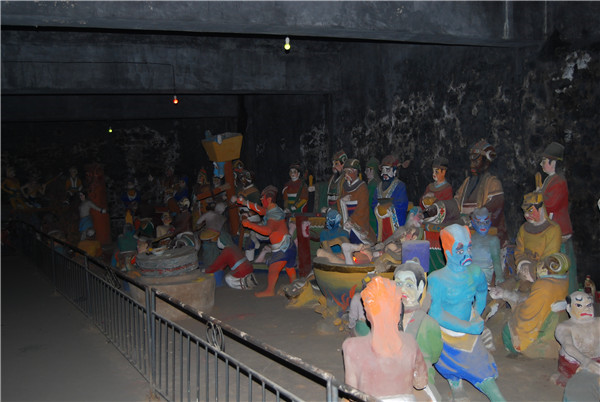
The first was the king of Qin Guangwang, the leader of Hell, who was mainly in charge of sorting and queuing people who did good or evil before life. To the good man who did good, he let them cross the golden bridge, reincarnation; To those who killed men and went off the beaten track, who committed crimes against women and men, he handed them over to the later king of the underworld to accept the corresponding punishment.
The second was the king of Chujiang, who mainly punished those who killed people before their death, including swords mountain prison and icebergs prison.
The third was Songdi, who punished those who had committed petty theft and put them in skinned prison. The latter one is the torture of gouging out the eyes, mainly to punish some of the ancient unfaithful women.
The fourth was the king of Wuguan, who mainly punished those who were not right in heart, stirred up trouble and dissension in the world, punishing them with taking out the tongue and fire-pit torture.
The fifth Yan Jun was the king of Yanluo, who was in charge of the most severe punishment in hell, the oil-pot and the guillotine prisons, specially punishing those who neglected their duties and committed crimes against corruption.
The sixth Yan Jun was the king of Biancheng, who specially punished people wasting food and throwing rice. Grain is the product of working people's blood and sweat. “Farmers are weeding at noon, their sweats are dripping down the soil, who knows the dishes of food, each grain is from hard work”.We Chinese people have always had the virtue of saving food. The punishment of gouging out the eyes were for the people who threw the rice flour and grinding their flesh into mud, though a little cruel, it reflected the hatred of the working people towards those who waste food.
The seventh Yan Jun was the king of Doushi. He mainly punished those unfilial daughters-in-law and unfilial children. The heated brick bed was to punish the unfilial daughter-in-law. It is said that there was a daughter-in-law who let her mother-in-law sleep on the cold Kang to freeze to death. So when she went to hell, the king of hell punished her by sleeping on the heated Kang to burn her soul. The torture that dig hearts is to punish unfilial son. Steelyard beam torture was meant to punish businessmen who traded while they were alive, they were short of weight and sold fake and inferior products.
The eighth Yan Jun was the king of Mount Tai. He mainly punished those who had been traitors before their death. He used the plowing and the stake tortures.
After the punishment, all the people would cross a small bridge called "Naihe Bridge". Naihe Bridge was one palm wide, ten li long and ten zhang high. If you fall down carelessly, you will never be reincarnated.
The 9th Yan Jun was the king of Pingdeng (Equality) who specialized in reexamination to see if there was any wrong punishment. If there was, the person had to go back to accept the punishment again; If not, he could go to the township stage to see his hometown and the past, and then to drink Meng Po's magic potion, forgetting the past things.
The tenth Yan Jun was the king of Zhuanlun. If one did good deeds, accumulated great virtues during his life, he would turn his life into a general or minister. Ordinary people would turn out to be ordinary people. If a person had done bad things in life, owing people money, then he would turn out of the cycle of birds and animals, accepting the baptism of nature.
Address:
No. 8 Feiyun West Road, Wanrong County
Charges:
Ticket Price: ¥15/person
Traffic guide:
County bus line: Bus Line 1
Hotline: 0359-4527977
Tour tips:
Food and specialties: Wanrong joke series, Upside-down watch, Jianmo (Pancake), Wanrong Bean Jelly, Baked wheaten bun, Yunxian Huabo (delicated wheaten bun)

